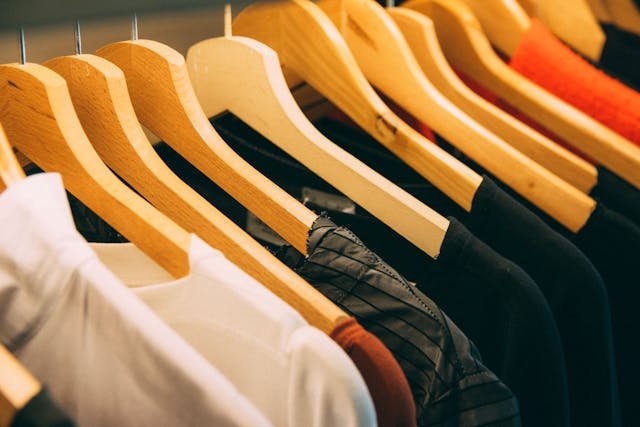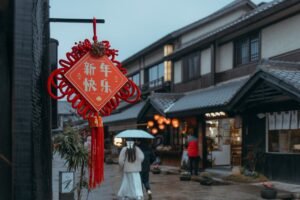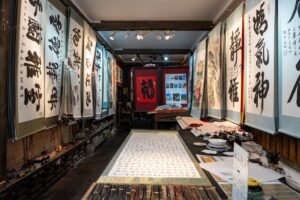Ever wondered how clothing, including garments like coats and formal clothes, in Chinese culture transcends mere fashion to embody rich historical and symbolic meanings, akin to cultural relics? From the vibrant hues of traditional Hanfu to the sleek lines of modern designs, clothing in Chinese society serves as a canvas, painting a picture of centuries-old traditions mingled with contemporary flair, where formal clothes and formal attire are seen not just as garments but as cultural relics. This post dives into the heart of Chinese apparel, exploring how each thread weaves together stories of cultural identity, social norms, and aesthetic values, focusing on the garment and clothing system including formal clothes and formal attire. Whether you’re a fashion aficionado or simply curious about the significance behind the styles, join us on this journey through the fabric of Chinese life, exploring the garment, clothes, formal attire, and clothing system. Discover how clothing, including clothes, garments, leather, and shoes, in Chinese culture is much more than what meets the eye.
Table of Contents
ToggleKey Takeaways
- Building a comprehensive vocabulary for clothing items in Chinese can significantly enhance your communication skills, especially in shopping scenarios or discussing fashion preferences.
- Learning practical phrases related to clothing not only aids in everyday conversations but also helps in navigating shopping experiences and cultural exchanges more effectively.
- Understanding the cultural significance of traditional garments provides valuable insights into Chinese culture and traditions, enriching your appreciation and respect for diversity.
- Familiarizing yourself with everyday attire in the Chinese context allows for a deeper connection with local customs and practices, making your interactions more meaningful and respectful.
- Knowledge of formal and wedding attire traditions in China can prepare you for participating in or attending significant events, ensuring you show the appropriate respect and etiquette.
- Staying informed about seasonal clothing recommendations can greatly improve your comfort and health, as well as facilitate smoother integration into local life when visiting or living in China.
Comprehensive Vocabulary for Clothing Items
Everyday Wear
Learning the Mandarin terms and words for everyday clothing items and garments is a great start with FluentU to enhance your vocabulary. Shirts, pants, and shoes are basics in any wardrobe, and knowing how to name these garments can be very useful for people interested in the clothing system.
Shirts, known as 衬衫 (chènshān) for men and T恤 (T xù) for casual T-shirts, are universal pieces. Pants or trousers go by 裤子 (kùzi). When it comes to shoes and clothes, the word 鞋子 (xiézi) covers all types, ranking highly among words people learning on FluentU should know. This basic vocabulary helps in daily conversations about clothing.
Traditional Attire
Diving deeper into Chinese culture, traditional attire such as qipao and hanfu, including clothes and shoes, hold significant cultural value for people, especially women. Qipao, a form-fitting dress known for its elegance, is referred to as 旗袍 (qí páo). Hanfu, representing ancient Chinese clothing styles, is called 汉服 (hàn fú). These terms not only enrich your language skills but also connect you to China’s rich heritage.
Qipao, traditional Chinese clothes for women, showcases intricate designs and is often worn by people on special occasions. Hanfu clothes bring history to life for people with its flowing silhouettes and detailed patterns. Understanding these terms offers a glimpse into how people and clothes shape China’s past and present fashion landscapes.
Gender-Specific Terms
For precise communication, it’s important to know the differences in vocabulary for men’s, women’s, and children’s clothing, as these terms help people understand the specific types of clothes being referred to. Men’s wear, a category of clothes, often includes specific terms like 西装 (xī zhuāng) for suits. Women’s clothing might use words like 裙子 (qún zi) for skirts.
Children’s clothes have their unique identifiers too. For example, 儿童服装 (ér tóng fú zhuāng) specifies kids’ apparel. These distinctions in clothes ensure clarity when shopping or discussing preferences in various settings.
Practical Phrases for Clothing Conversations
Shopping Essentials
Navigating clothing stores in China or conversing with Chinese-speaking friends about fashion necessitates a repertoire of practical phrases related to clothes. Here, we delve into expressions vital for shopping for clothes, including inquiries about sizes and prices.
To ask for a different size in clothes, one might say, “请问有没有更大(小)的尺码?” (Qǐngwèn yǒu méiyǒu gèng dà (xiǎo) de chǐmǎ?), translating to “Do you have a larger (smaller) size?” This question is crucial when the item you’re interested in isn’t your fit.
When it comes to finding out how much an item costs, the phrase “这个多少钱?” (Zhège duōshǎo qián?) is your go-to. It means “How much is this?” and is arguably one of the most useful phrases in any shopping scenario.
Compliments & Queries
Complimenting someone’s outfit or inquiring where they purchased their clothes not only serves as a conversation starter but also reflects interest and appreciation for the individual’s style.
A simple compliment can be made using “你的衣服很漂亮!” (Nǐ de yīfú hěn piàoliang!), which means “Your clothes are very beautiful!” Such expressions foster positive interactions and can lead to more engaging conversations about fashion preferences.
If you’re curious about where someone bought their outfit, asking “请问你的衣服在哪里买的?” (Qǐngwèn nǐ de yīfú zài nǎlǐ mǎi de?) translates to “May I ask where you bought your clothes?” This could reveal new shopping destinations or brands worth exploring.
Discussing Preferences
Discussing clothing preferences and styles is essential in expressing one’s identity and understanding others’. Phrases that facilitate such discussions include expressing likes and dislikes.
To express preference for a certain style, one might say, “我喜欢穿休闲风格的衣服。” (Wǒ xǐhuān chuān xiūxián fēnggé de yīfú.), meaning “I like wearing casual style clothes.” This statement offers insight into personal taste and lifestyle choices.
Conversely, expressing dislike can be done through “我不太喜欢太正式的衣服。” (Wǒ bù tài xǐhuān tài zhèngshì de yīfú.), which translates to “I don’t really like too formal clothes.” Such expressions are key in navigating conversations about personal style preferences.
Cultural Insights into Traditional Garments
Historical Evolution
China’s rich history is mirrored in its traditional attire, with garments like the cheongsam and tangzhuang standing out as cultural icons. These pieces not only represent fashion but also China’s deep-rooted traditions and evolving society.
The cheongsam, known for its elegance, evolved from ancient robes. It became popular in the 1920s among women for its form-fitting style that highlighted the female figure. Men’s tangzhuang jackets, on the other hand, gained prominence during the Qing Dynasty. They are characterized by their Mandarin collars and intricate button knots. Both garments have undergone various modifications over centuries, adapting to changing tastes while maintaining their cultural essence.
Symbolism and Occasions
Traditional Chinese clothing carries significant symbolism. Colors, patterns, and designs often convey messages of luck, prosperity, and happiness. For instance, red is favored during weddings and New Year celebrations for its association with good fortune.
Today, traditional attire is worn during festivals, weddings, and other ceremonial events to honor heritage and express identity. The cheongsam and tangzhuang are not just outfits but a bridge connecting the past with present-day celebrations of Chinese culture.
Regional Variations
China’s vast geography has given rise to diverse regional clothing styles that reflect local customs and climates. In northern regions, heavier fabrics keep wearers warm against cold winds. Here, you might find thicker tangzhuangs made from wool or leather.
In contrast, southern China’s warmer climate favors lighter materials like silk and cotton. Here, variations of the cheongsam might be more prevalent in daily wear due to its breathable fabric and comfortable fit.
This diversity illustrates how traditional Chinese clothing adapts to different environments while preserving unique regional identities.
Everyday Attire in Chinese Context
Urban Trends
In China’s bustling cities, ordinary people often embrace a blend of traditional and modern fashion. They wear comfortable yet stylish clothing that suits the fast-paced urban lifestyle. Recent trends show a significant influence of Western fashion, with young adults sporting jeans, T-shirts, and sneakers as part of their daily attire.
However, it’s not just about copying the West. Many urbanites also incorporate elements of traditional Chinese clothing into their outfits. For instance, a young professional might pair a sleek blazer with a silk scarf featuring patterns inspired by ancient Chinese art.
Rural Dress
In contrast, rural areas of China showcase a different story. Here, practicality takes precedence over fashion trends. People usually wear simple, durable clothes that can withstand the physical demands of agricultural work. This often includes loose-fitting trousers and shirts made from hardy materials.
Despite this focus on functionality, rural residents still find ways to express their cultural identity through clothing. During festivals or special occasions, they might don traditional garments that have been passed down through generations.
Western Influence
The impact of Western fashion on Chinese clothing choices is undeniable. Global brands are increasingly popular among both urban and rural populations. This has led to a fusion of styles, where traditional Chinese elements are mixed with contemporary Western trends.
This blending is particularly evident among the youth who are keen to experiment with their looks while still paying homage to their cultural heritage. It reflects a broader trend of globalization but also highlights the unique way in which Chinese people negotiate between tradition and modernity.
Climate Considerations
China’s vast geography means its climate varies dramatically from one region to another, significantly influencing everyday attire. In northern areas with harsh winters, people layer up in heavy coats and woolen scarves. Meanwhile, in the humid south, lighter fabrics like cotton and linen dominate daily wear to help cope with the heat.
This geographical diversity ensures that clothing in China is not just about aesthetics but also about adapting to the environment. It showcases how ordinary people make practical decisions based on local weather patterns while still adhering to societal norms around dress.
Formal and Wedding Attire Traditions
Traditional Wear
In China, traditional wedding attire is a significant aspect of the ceremony, symbolizing not just personal style but also cultural pride. For women, the qipao, a form-fitting dress that evolved from the Manchu women’s cheongsam of the 17th century, stands out as a popular choice. Its elegance and simplicity make it an enduring symbol of Chinese femininity.
Men often opt for darker suits, signifying their status and role in the ceremony. The choice of attire goes beyond mere aesthetics; it embodies centuries of tradition and cultural values.
Color Significance
Colors play a crucial role in Chinese formal wear, especially in weddings. Red, considered auspicious and symbolic of luck and joy, dominates. Couples usually incorporate red into their wedding attire to bless their union with happiness and prosperity.
Gold accents are also common, adding an element of prestige and wealth to the celebration. Together, these colors reflect a deep-rooted belief in fortune and success, making them indispensable in ceremonies and festivals.
Modern Adaptations
While traditional styles remain respected, modern adaptations have found their place in Chinese formal attire. Young couples often blend contemporary fashion trends with classic elements for a more personalized look. This might mean pairing a traditional qipao with modern accessories or opting for suits in unconventional colors.
These changes reflect shifting preferences among the younger generation who seek to balance respect for heritage with individual expression.
Comparison
Comparing modern adaptations to traditional styles reveals a dynamic fashion landscape in China. While elders may prefer the time-honored designs of qipaos and dark suits for formal occasions, many young people experiment with bold colors and patterns.
This evolution underscores a broader trend: as society progresses, so too does its expression through clothing. Yet, regardless of these changes, the core principles of respect for tradition and family remain steadfast.
Seasonal Clothing Recommendations
Spring Layers
Spring in China brings a mix of warm days and cool nights, making layering essential. Lightweight jackets become a staple during this season. They offer flexibility, allowing individuals to adjust comfortably as temperatures fluctuate throughout the day.
A versatile jacket can serve as both a fashion statement and a practical piece. Pair it with breathable fabrics like cotton or linen for daytime warmth and comfort. As evenings can still be brisk, carrying a scarf or a light sweater provides an extra layer of warmth when needed.
Summer Essentials
The summer months in China can be intensely hot and humid, especially in cities like Shanghai and Guangzhou. Choosing clothing made from natural fibers such as cotton or linen helps the body breathe and stay cool.
For daily wear, loose-fitting shirts paired with shorts or skirts are advisable. These items allow air circulation, reducing discomfort from the heat. To protect against the strong sun rays, wide-brimmed hats and sunglasses are also recommended. During this time, many festivals occur outdoors. Participants should opt for comfortable yet culturally respectful attire, ensuring they enjoy these events fully.
Autumn Attire
Autumn sees a gradual drop in temperature, offering a respite from the summer heat. This season is perfect for exploring outdoor attractions without the extremes of summer or winter weather. Layering remains key, with medium-weight jackets regaining their place in daily outfits.
Incorporating items like long-sleeve tops and light sweaters into one’s wardrobe allows for easy adjustment to varying temperatures throughout the day. Footwear also transitions during this period; closed-toe shoes provide comfort while keeping feet protected against cooler breezes.
Winter Warmth
Winters can be harsh in many parts of China, particularly in the north where temperatures often dip below freezing. Heavy coats or down jackets are indispensable during this time. They offer necessary insulation against cold winds and snow.
Layering is crucial for maintaining warmth without sacrificing mobility. Thermal undergarments act as a base layer beneath regular clothing, trapping body heat effectively. For those attending formal events or traditional festivals during winter months, dressing warmly does not mean compromising on style; elegant coats and accessories can complement formal attire seamlessly.
Accessories and Jewelry in Mandarin
Key Vocabulary
Belts, hats, and scarves are more than just functional items; they add flair to any outfit. In Mandarin, a belt is called “带子 (dàizi),” a hat is referred to as “帽子 (màozi),” and a scarf is known as “围巾 (wéijīn).” These accessories can transform a seasonal outfit, as discussed in the preceding section on seasonal clothing recommendations, into something truly special.
Hats not only protect from the sun but also serve as a stylish statement. Scarves offer warmth and a pop of color or texture. Belts cinch outfits together, providing both form and function.
Cultural Significance
Jewelry holds a deep cultural significance in Chinese society. Traditional pieces like jade bracelets are not merely adornments. They symbolize protection and good fortune. Jade itself is highly valued for its beauty and supposed health benefits.
The wearing of gold jewelry during weddings and special occasions signifies wealth and happiness. These traditions highlight the importance of materials and craftsmanship in Chinese culture. Each piece tells a story, carrying with it centuries of history and meaning.
Purchasing Phrases
When discussing or purchasing accessories and jewelry in Mandarin, focusing on materials and craftsmanship is key. Phrases such as “这是什么材料做的?(Zhè shì shénme cáiliào zuò de?)” which means “What material is this made of?” are useful.
Asking about craftsmanship, you might say, “这个手工怎么样?(Zhège shǒugōng zěnme yàng?)” translating to “How is the craftsmanship?” Understanding these phrases enhances the shopping experience, allowing for deeper appreciation of the item’s quality.
Discussing price, one might ask, “这个多少钱?(Zhège duōshǎo qián?)” meaning “How much does this cost?” It’s essential to know these phrases to navigate markets or stores confidently.
Shopping for Clothes in China
Market Navigation
Navigating clothing markets in China offers a vibrant and diverse shopping experience. Shoppers should come prepared to dive into a sea of options, from traditional attire to the latest fashion trends. Bargaining is an art form here. Start by offering half the initial price and negotiate up. It’s a dance of numbers and patience, but with practice, you’ll snag incredible deals.
Markets often sprawl across several streets or floors in a building. Each vendor showcases unique styles, making it easy to find something that catches your eye. Remember, cash is king in these bustling bazaars. Many vendors prefer it over digital payments, so keep some on hand.
Local Brands
China’s fashion scene is booming with talented designers and popular brands that blend traditional elements with modern aesthetics. Brands like Bosideng specialize in outerwear and have gained international acclaim for their quality down jackets. Meanwhile, Urban Revivo offers trendy pieces at affordable prices, perfect for those looking to update their wardrobe without breaking the bank.
For a taste of luxury, Shang Xia crafts exquisite garments that reflect Chinese heritage with a contemporary twist. These brands represent just the tip of the iceberg in China’s rich fashion landscape.
Size Conversion
Foreign shoppers often find size conversion challenging when shopping for clothes in China. Sizes tend to run smaller compared to Western standards, so it’s crucial to check size charts carefully or ask staff for assistance. Most stores display size information in both Chinese and international measurements, making it easier to find the right fit.
Fitting rooms follow a similar etiquette as elsewhere but always ask before entering with multiple items. Some boutiques limit the number of pieces you can try on at once due to high demand and limited space.
最后的话
Diving into the world of Chinese clothing isn’t just about expanding your vocabulary; it’s an adventure into a rich tapestry of culture, tradition, and modernity. You’ve now got the essentials to chat about everything from silk qipaos to the latest streetwear trends in Mandarin. This knowledge doesn’t just bridge language gaps; it opens doors to deeper connections and understanding. Whether you’re shopping in bustling markets, discussing wedding attire, or simply curious about seasonal wear, you’re equipped to engage and impress.
Don’t stop here. Take this insight, explore further, and weave these elements into your conversations and travels. Share your experiences, ask questions, and dive deeper into the fascinating world of Chinese clothing culture. Your journey has just begun. Ready to explore more? Let’s keep the conversation going.
Frequently Asked Questions
What are some basic vocabulary words for clothing items in Chinese?
Chinese clothing vocabulary includes terms like 衣服 (yīfu) for clothes, 裤子 (kùzi) for pants, and 衬衫 (chènshān) for shirt. These foundational words help when shopping or discussing clothing.
How do I ask for a different size in Chinese?
To ask for a different size, you can say “我可以试一个更大/更小的吗?” (Wǒ kěyǐ shì yīgè gèng dà/gèng xiǎo de ma?) which means “Can I try a bigger/smaller one?”
Can you explain the significance of traditional Chinese garments?
Traditional garments like the Qipao and Hanfu carry deep cultural significance, representing China’s rich history and aesthetics. They are worn during festivals, weddings, and formal events to honor tradition.
What is typical everyday attire in China?
Everyday attire in China varies widely but often includes comfortable and practical pieces like T-shirts, jeans, and lightweight tops, reflecting modern fashion trends while accommodating the diverse climate.
What should I know about wedding attire traditions in China?
In Chinese weddings, red is a dominant color symbolizing luck and happiness. Brides often wear a red Qipao or Cheongsam, while grooms might wear traditional Hanfu or modern suits.
What seasonal clothing is recommended in China?
Seasonal recommendations include lightweight fabrics for summer to combat the heat and humidity, layers during spring and autumn for fluctuating temperatures, and warm jackets or coats in winter to stay cozy against the cold.
Are there any tips for buying accessories and jewelry in Mandarin-speaking areas?
When shopping for accessories or jewelry in Mandarin-speaking areas, knowing terms like 首饰 (shǒushì) for jewelry and 手表 (shǒubiǎo) for watches can enhance your experience. Bargaining is common in markets but less so in malls or branded stores.








